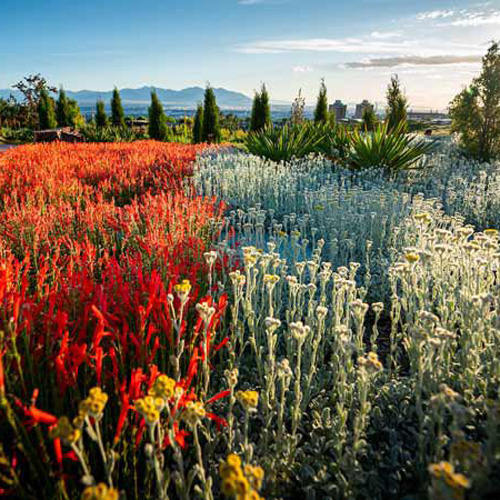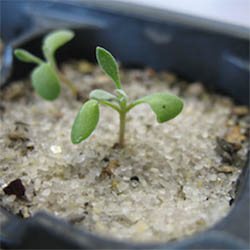RED BUTTE GARDEN CONSERVATION AND RESEARCH

The Red Butte Garden Conservation and Research Department focuses on three major areas of research: Conserving Rare Plants, Developing Useful Plants, and Improving Wild Land Development.
Sarah Jack Hinners, PhD, LFA
Director of Conservation and Research
What kind of work do we do?
We are stewards of the at-risk plants in our region, and protecting them is a key component of Red Butte Garden’s mission. We hope to mitigate threats and preserve genetic information so that rare populations may recover in their native habitats, thereby conserving the biodiversity of our native flora and fauna.
In-situ conservation is work that is in the area where the plant naturally grows. We collect plant samples and seeds to study later, monitor populations, transplant endangered species out of harm’s way, and re-vegetate with seeds or seedlings in their native habitats.
Ex-situ conservation is work that is done at Red Butte Garden or at other facilities around the West. This work involves off-site storing seeds in seed banks to preserve the genetic material, testing seed germination and viability to better understand how to propagate a species, and studying living specimens that have been propagated or salvaged from project sites.
What is biodiversity?
Biodiversity is the number of different species of plants and animals found within a particular region, or ecosystem. The more diverse an ecosystem, meaning the more plants, animals, insects, and bacteria living within it, the healthier it is. A biodiverse ecosystem has more resources to draw on that allow it to bounce back from disturbances, adapt to long-term changes, and support the communities within it, wild or cultivated.
Why does it matter?
While biodiversity is critical for the sake of the environment in and of itself, there are a number of reasons biodiversity should matter to people. Plant diversity provides us with key ingredients and products that feed us, shelter us, keep us healthy, and fuel our economy. To destroy a species, actively or unknowingly, is to destroy its potential for generations to come.

Conducting Research in the Garden
Red Butte Garden also hosts and partners with outside researchers and collaborators to facilitate studies on plant-related topics ranging from plant physiology to sustainable landscapes to Nature Rx. If you are interested in partnering with Red Butte Garden on conservation or research projects, or conducting research at the Garden, please reach out to sarah.hinners@redbutte.utah.edu or 801-585-5853.

Germination and Propagation Trials
Partner: BLM and Center for Plant Conservation (CPC)
Duration: Ongoing
Summary: At the Garden, we are currently testing seeds from our seed bank in order to develop the best protocols for germinating rare plant species. Once seeds have germinated, we maintain them in our greenhouses and track their growth each month in order to pinpoint the best methods for propagation. Many of the species we work with require very specific conditions for growth, and by sustaining these species in our greenhouses, we can determine the feasibility of growing seedlings for future out-planting and restoration studies.
What Can You Do?
Plant Native Plants, Pull Invasive Species
Your land, however small, can be an important piece of habitat for native plants, pollinators, and other wildlife. As our cities expand outward, eating up true native habitats, these oasis become critical to support native populations.
What to Plant:
- Gardening for Native Bees in Utah from USU Cooperative Extension
- Ecoregional Planting Guides from The Pollinator Partnership
- Native Plant Resources from the Utah Native Plant Society
What to Pull:
See Our Past Projects
RANA Technology, Endangered Plant Propagation, Seed Banking, Blackrock Gypsum Revegetation